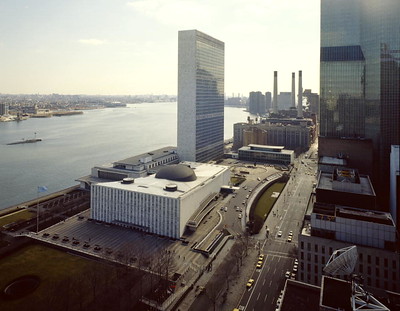The establishment of the United Nations headquarters is one of the accomplishments completed during the Cold War. In 1946, the United Nations officials decided to construct the headquarters, after the League of Nations failed to protect the United States from World War II conflicts.[1] Zipp acknowledges how the construction of the UN Headquarters will “become the prototype for federal rebuilding policies.”[2] Wallace K. Harrison, an architect, was assigned to plan the design of the headquarters. [3] Zipp retells the UN officials’ statement of the purpose for establishing the UN headquarters, saying that “it would grow as the whole body, … designing its new home” and advocate for “global peace.”[4] Robert Moses, one of the most famous New York urban planners, was also contributed towards the establishment of the United Nations headquarters by advising construction plans.[5] The United Nations design was organized into “three primary structures,” which are “Secretariat,” the “Council Building,” and “General Assembly Building.”[6] Zipp asserts that the U.N. officials not only founded a new organization to improve their civil defenses, but the headquarters also influenced architects “to redeem the city.”[7]
[1] Samuel Zipp, Manhattan Projects: The Rise and Fall of Urban Renewal in Cold War New York, (New York, NY: Oxford University Press, 2010), 37
[2] Samuel Zipp, Manhattan Projects: The Rise and Fall of Urban Renewal in Cold War New York, (New York, NY: Oxford University Press, 2010), 69
[3] Samuel Zipp, Manhattan Projects: The Rise and Fall of Urban Renewal in Cold War New York, (New York, NY: Oxford University Press, 2010), 43
[4] Samuel Zipp, Manhattan Projects: The Rise and Fall of Urban Renewal in Cold War New York, (New York, NY: Oxford University Press, 2010), 42
[5] Samuel Zipp, Manhattan Projects: The Rise and Fall of Urban Renewal in Cold War New York, (New York, NY: Oxford University Press, 2010), 37
[6] Samuel Zipp, Manhattan Projects: The Rise and Fall of Urban Renewal in Cold War New York, (New York, NY: Oxford University Press, 2010), 43
[7] Samuel Zipp, Manhattan Projects: The Rise and Fall of Urban Renewal in Cold War New York, (New York, NY: Oxford University Press, 2010), 69
